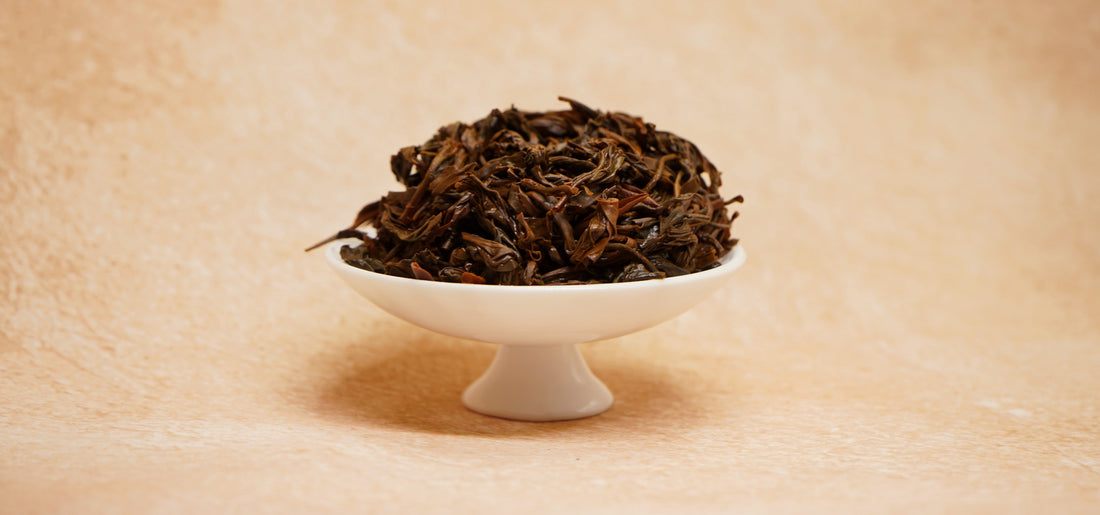
Beschaffung von sonnengetrocknetem wildem roten Tee
Aktie
Diesen Frühling haben wir einen wilden roten Tee aus Wuliang Shan bezogen. Mehr über Wuliang Shan erfahren Sie in unserem vorherigen Blogbeitrag.
Wuliang Shan verfügt über eine beträchtliche Anzahl wilder Teebäume: nicht-klonale, genetisch vielfältige Varietäten der Camellia Sinensis var. Assamica und var. Taliensis, die in Yunnan heimisch sind. Wir wollten Wildbaummaterial für einen roten Tee verwenden und bestellten es daher beim Bauern vor. Zusätzlich baten wir um eine Sonnentrocknung für diesen Tee. In diesem Blog erklären wir, warum wir Wildbaummaterial und Sonnentrocknung bestellt haben.
Wildbäume und Kulturbäume
In Yunnan werden kultivierte Bäume aus speziellen Klonsorten auf großen Plantagen angepflanzt, vor allem um höhere Erträge und eine gleichbleibende Produktion zu erzielen. Der von kultivierten Bäumen produzierte Rottee ist oft kräftiger, kann aber beim Aufbrühen bitter und adstringierend sein. Wild wachsende Bäume sind genetisch vielfältig und haben eine ganz andere Wirkung auf den Tee. Sie ergeben oft Tees, die länger haltbar sind und weniger bitter und adstringierend sind. Warum? Ökologische Studien haben gezeigt, dass die Blätter wild wachsender Bäume in Yunnan im Allgemeinen zäher sind und mehr Fasermaterial sowie dickere Mesophyll-, Epidermis- und Kutikulaschichten aufweisen. Das bedeutet, dass sie über reichlich Geschmacksvorläufer verfügen und strukturell widerstandsfähiger gegen das Aufbrühen mit kochendem Wasser sind. Wild wachsende Bäume wachsen außerdem in nährstoffreichem Waldboden, was zu einem komplexeren Geschmack und Nachgeschmack beitragen kann.

Das soll nicht heißen, dass Wildbäume grundsätzlich besser für Roten Tee geeignet sind als Kulturbäume. Es gibt viele hervorragende Yunnan-Rottees, die ausschließlich aus Plantagenbäumen hergestellt werden. Dieses Jahr wollten wir jedoch einen Yunnan-Rottee mit einem bestimmten Profil beziehen: einen milderen, „introvertierten“ Charakter, der über viele Aufgüsse hinweg anhält und einen komplexen, fruchtigen Nachgeschmack hat. Für die Art von Roten Tee, die wir suchten, mussten wir nach altem Wildbaummaterial suchen und glücklicherweise fanden wir welches auf dem Wuliang-Berg. Nachdem wir das Material gefunden hatten, mussten wir uns Gedanken über die Verarbeitungstechniken machen. Für dieses Roten-Tee-Profil benötigten wir Sonnentrocknung statt Heißlufttrocknung.
Sonnentrocknung und Heißlufttrocknung
Früher wurde Yunnan-Rottee in der Sonne oder mit Heißluft getrocknet. Die Sonnentrocknung ist die ältere Methode, als Öfen und Trocknungsmaschinen noch nicht so verbreitet waren. Heutzutage wird Yunnan-Rottee häufig mit Heißluft getrocknet, da dies schneller geht, sich besser für die Massenproduktion eignet und ein gleichbleibend gutes Produkt liefert.

Obwohl es viele gute heißluftgetrocknete rote Tees auf dem Markt gibt, ist unserer Erfahrung nach die Sonnentrocknung besser geeignet, wenn der Rohstoff von älteren Wildbäumen stammt. Wie bereits erwähnt, können Wildbäume eine größere aromatische Komplexität aufweisen als Plantagenbäume. Daher möchten wir diese aromatische Komplexität während der Verarbeitung so weit wie möglich erhalten. Nach der Oxidation scheint es der beste Weg, die Komplexität zu erhalten, zu sein, eine langsamere Oxidation und leichte Fermentation während des Trocknungsprozesses zuzulassen.
Da die Sonnentrocknung an der Luft stattfindet, oxidieren die Teepolyphenole während des Trocknungsprozesses langsam weiter, ähnlich wie bei der Trocknung von Pu-Erh-Tee. Natürliche Enzyme können auch bei sanfter Sonneneinstrahlung aktiv bleiben, was eine schonende Fermentation ermöglicht. Bei der Heißlufttrocknung werden die Blätter in einer geschlossenen Umgebung einer viel höheren Temperatur ausgesetzt. Dies stoppt die Oxidation und sterilisiert die Blätter effektiv, wodurch jegliche enzymatische Aktivität unterbrochen wird. Das Endergebnis ist ein sonnengetrockneter roter Tee, der gealtert werden kann. Durch die Sonnentrocknung bleiben einige komplexe aromatische Verbindungen erhalten, und der Tee kann durch die Fermentation während der Lagerung ein fruchtiges oder hopfiges Aroma entwickeln. Einige Studien bestätigen, dass sonnengetrockneter Tee höhere Konzentrationen bestimmter Verbindungen enthält, insbesondere Koffein, Catechine und freie Aminosäuren.
Heißluftgetrocknete Tees hingegen sind in der Regel etwa zwei Jahre lang am besten haltbar. Sie altern oder entwickeln sich nicht weiter, da die enzymatische Aktivität durch die höhere Temperatur gestoppt wurde. Der intensivere Hochtemperaturprozess kann angenehme schokoladige oder malzige Noten erzeugen, führt aber auch eher zu einem einfacheren Geschmacksprofil mit einem flüchtigeren Aroma in der Nase. Bei sonnengetrocknetem Tee kann der Duft komplexer sein und bleibt länger im Hals.
Unser Wunsch nach einem interessanteren Rottee mit größerer Komplexität und einem intensiveren Nachgeschmack hat uns dieses Jahr dazu bewogen, für unseren wilden Rottee Wildbaummaterial und ein Sonnentrocknungsverfahren zu verwenden. Wir hoffen, er schmeckt Ihnen.

Verweise
Zhang, L., Chen, H., Chen, Z., et al. (2022). Veränderungen des Koffein- und Catechingehalts in sonnengetrocknetem Schwarztee aus Camellia sinensis var. assamica. Journal of Food Composition and Analysis, 109, 104453.
Li, R., et al. (2019). Einfluss von Trocknungsmethoden auf die Qualität und chemische Zusammensetzung von schwarzem Tee. Food Research International, 120, 30–37.
Zhang, Y., Zeng, Q., et al. (2016). Anatomische Struktur und Blattdicke von Camellia taliensis und kultivierter C. sinensis var. assamica in Yunnan. Botanical Bulletin of Academia Sinica, 57(2), 127–138.
